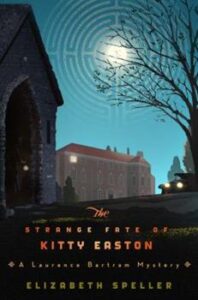by Elizabeth Speller; reviewed by Jeannette Hartman
 When Laurence Bartram’s friend, architect William Bolitho, invites him to look at the Easton Deadall church, Laurence accepts without hesitation.
When Laurence Bartram’s friend, architect William Bolitho, invites him to look at the Easton Deadall church, Laurence accepts without hesitation.
The term has ended at the boys school where he has been teaching, and he must decide whether to try for another position there or to accept an offer to tutor a wealthy Italian man’s son in Italy. His book on the churches of London has been published and he’s interested in seeing what caught William’s attention in Easton Deadall.
Like Laurence, William is a veteran of the Great War. The war cost him both legs and made work scarce. His wife, Eleanor, is friends with Lydia Easton’s half-sister Frances. That led to Lydia hiring William to design a memorial maze by the church in honor of the village men who died during the war. She also asked him to design a stained glass window for the church and upgrade the estate workers’ cottages.
The church has “charm. But it’s an odd sort of place, clumsily restored last century,” according to William Under decaying flooring, workmen discover a geometric design that looks ancient. William wants Laurence to assess it.
What Laurence finds is a church much older than it appears. He only gradually uncovers its many layers and secrets. He also finds a family and an estate shadowed by the disappearance of Lydia’s five-year-old daughter Kitty 15 years earlier.
Lydia refuses to accept that she was dead. She refuses to have her legally declared dead and still speaks of her in the present tense.
The girl’s father, Digby Easton, died in 1917 during the war along with most of the village men who had signed up in solidarity with him. Lydia is frail and in failing health. Julian, Digby’s brother, survived the war. He would have inherited the estate had Kitty been declared dead. He clearly is in love with Lydia.
Laurence uncovers plenty of hidden mysteries in the church, including a dead body and prehistoric wall paintings. Just as he did in the first book of this series, THE RETURN OF CAPTAIN JOHN EMMETT, Laurence keeps pulling on threads, asking questions and seeking out people with bits of information to finally solve the mystery of Kitty Easton’s disappearance.
This is a somber mystery. It focuses less on the Great War than on the aftermath: villages of widows and children; and estates struggling to function without men to run or work them. Eleanor’s independence of thinking and passion for empowering women and improving conditions in the world contrasts sharply with the Easton women, who were imprisoned by marriage and at the mercy of demanding, abusive and alcoholic men.
As Laurence digs at the questions surrounding Kitty’s disappearance someone describes him as an observer, someone who sits on the sidelines and doesn’t engage with life.
Ultimately that is an issue he confronts in deciding whether to continue teaching or go to Italy. Should he let his London apartment, which he loves, go — or should he keep it? Should he keep hoping that Mary Emmett, whom he fell in love with in the first book, will ever be emotionally available for a relationship — or should he move on with his life?
Although this is the second book in a series, it can be read without reading the first.
The Author: Elizabeth Speller
 Elizabeth Speller is a writer, teacher, journalist and a prize winning poet.
Elizabeth Speller is a writer, teacher, journalist and a prize winning poet.
This book is a sequel to THE RETURN OF CAPTAIN JOHN EMMETT (2011). Her other works include THE FIRST OF JULY (published in the United Kingdom as AT BREAK OF DAY in 2021), a memoir THE SUNLIGHT ON THE GARDEN: A FAMILY IN LOVE, WAR AND MADNESS (2012) and a nonfiction book, FOLLOWING HADRIAN (2022).
She has contributed to publications as diverse as the Financial Times, Big Issue and Vogue.
Born in Oxford and educated in London and Cambridge, she holds degrees in classics and ancient history.


